Editor's Picks: Of The Essence
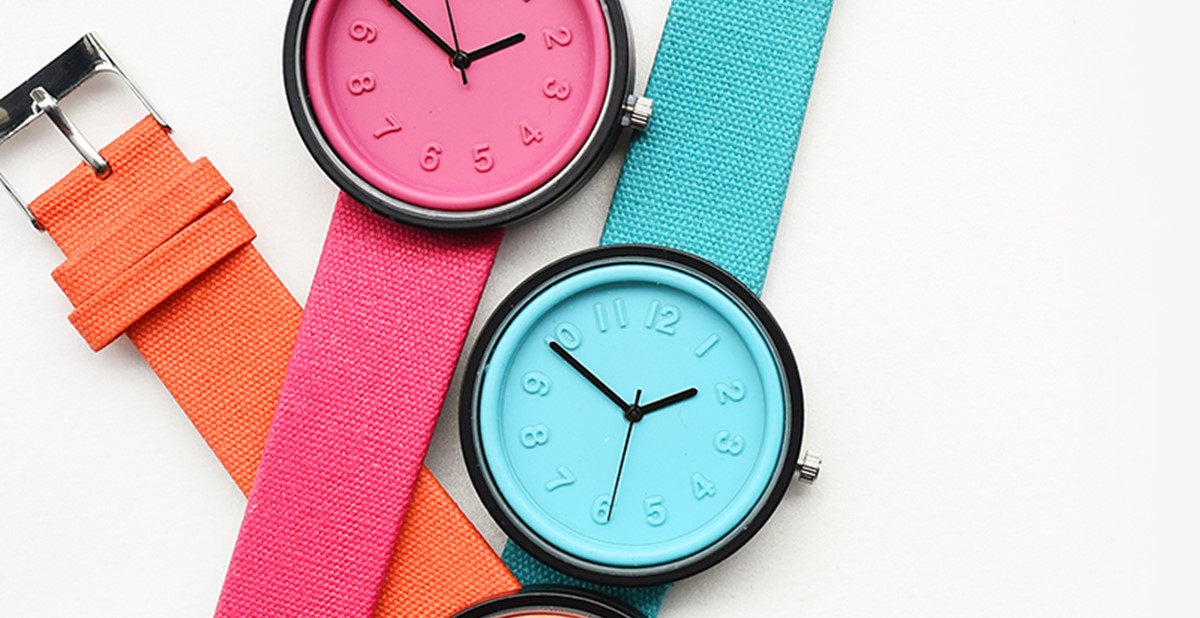
Keeping track of time is an innate ability that all life forms are born with. All living creatures must know the time to adjust to their environment as it changes. For example, when winter is over, bears wake from hibernation, flowers bloom and birds return from their migration south. Even humans have evolved with internal clocks, known as a circadian rhythm, that regulate our sleep-wake cycle in tune with each rotation of the Earth. But unlike other creatures, humans have gotten more precise at tracking time. As our society has become increasingly complex, people have been forced to think about time differently.
For the forager living 100,000 years ago, the rhythms of the natural world were the only timekeepers. No special instruments were required with the sun and the stars to follow, and aligning activities up with those of their friends and family was effortless in small, foraging communities. But for emerging agricultural societies, they needed more reliable and accurate methods of keeping time to know when to plant crops or sell vegetables at the nearby village. A standard measurement of time that everyone agreed on was now key to an orderly society. German scholar Norbert Elias argues in his book Time: An Essay that people began to require more precise clocks and more accurate records because individual schedules were becoming intertwined with other networks of people. “In people’s experience, the immediate present—that which is here and now—stands out more sharply than either past or future. Human actions, too, tend to be more highly centered on present needs and impulses,” says Elias. To be in sync with the rest of the world, tracking what others are doing and when they are doing it is crucial.
The alarm clock has been helping people stay on schedule, waking them up for work and school, since the 16th century. Despite its rude awakening, the alarm clock is essential when you’ve got a flight to catch or a test to take. Today’s alarm clocks are multi-functional, combining different features like a Bluetooth speaker or a wireless charging station into one all-purpose product. While most people use a sound-based alarm, studies find that it’s best to naturally wake up or to at least use a light-based alarm clock. The human body is remarkably sensitive to light and dark; our bodies cue the release of hormones associated with wakefulness in bright environments and sleepiness in dark environments. According to the Sleep Station, a light-based alarm clock is a more natural alternative to a sound-based alarm clock.
Light-based alarm clocks typically work by raising the intensity of the light they emit shortly before the desired waking time to mimic the effect of a rising sun, giving a more gradual “waking up” process that is more in tune with the natural sleep cycle. Sound-based alarm clocks shock users into wakefulness. When users wake up this way, they can experience sleep inertia—feeling groggy, disoriented and in a bad mood. Waking up with light instead can cause users to feel more alert, enhance mood and lead to better memory and concentration throughout the day. Before the first alarm clock was invented in 1787, people were using creative ways to drag themselves out of bed in the morning. From professional human alarm clocks called “Knocker uppers” who would tap on their customers’ bedroom windows until they were assured the person was awake, to Native American warriors who could determine, in advance, their hour of rising by regulating the amount of water they drank before going to bed, alarm clocks have taken many different shapes and forms.
For the hourly worker, time determines pay. Most of the business world continues to bill work using manual, memory-based time tracking which, according to an article in Harvard Business Review, is costing the U.S. economy $7.4 billion a day. A recent study from AffinityLive, a company that specializes in professional services automation, surveyed 500 workers and found that each person lost $50,000 per year in revenue due to insufficient tracking of emails with clients and others. Manual time-tracking, riddled with error and guesstimation, does not accurately represent time spent working. Although we are born with internal clocks, human cognitive processing, unlike a computer, needs regular downtime, while manual time tracking requires constant attention for accuracy.
The human brain doesn’t even process event duration uniformly. Time can be elastically sped up and slowed down depending on our emotional state, and the amount of new or important information we encounter warps our perception of how much time we spend on a task. Detailed time tracking is a doomed task and a design failure that does not reflect how our brains work. Many professionals have begun to realize this and have started automating their time tracking. Instead of using timers or spreadsheets, they use secure software or leverage AI to meticulously record the time spent on documents, tasks, apps and websites.
Time is our most valuable commodity, anchoring people to the present. People will continue to use time to guide their daily activities and commune with others, making time products ever-present and relentlessly of the essence for every end user.
–––––––––––––––––––––––––––––––––––––––––––––––––––––––––––
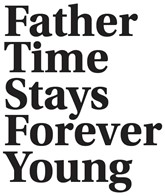
Within a few centuries, as people have grown more accustomed to keeping time, personal watches have transformed from the flattened and curved pocket watch to the multi-functional, high-tech smartwatch. For those looking to better manage their time, innovative time products have endless benefits.
The first mechanical clock was invented in England in 1275, and used gears with a spring instead of water or weights. This design paved the way for compact timepieces like pocket watches and wristwatches. In the 1540s, the Swiss watch industry was born when reformer John Calvin banned people from wearing jewelry. Jewelers were forced to learn a new craft: watchmaking. In 1574, the first known pocket watch was created in bronze, instead of iron, which was previously used, with religious depictions on both the front and back. However, it wasn’t until 1680 that the minute hands were added to clocks. In the 1700s, clock ownership became more widespread, and manufacturers began producing all kinds of clocks from large grandfather clocks to small, decorative table clocks.
Following mass production of the 19th century, the first wristwatch was created in 1812 for the wrist of the Queen of Naples. Damage-prone wristwatches were primarily worn by women while men carried pocket watches that could better survive the elements. But wristwatches became more popular for men in the military. During World War I, pulling out a pocket watch to check the time, which meant that soldiers could not fully carry all their equipment. To keep their hands free, soldiers were given wristwatches called “trench watches.” Wristwatches soon became part of an officer’s war front kit.
Today’s wristwatch wearers are still looking to keep their hands free while remaining fully connected to the world. In 2018, the total U.S. wholesale watch market grew 13 percent to $8.8 billion, driven by a 54-percent increase in sales of smartwatches, according to The NPD Group. “We have entered a new watch universe where smart options have become as significant as the traditional,” says Reginald Brack, watches and luxury industry analyst, The NPD Group. “Smartwatches are today’s growth engine, but there is still a place for traditional watches among consumers and in the marketplace.”
And consumers are still changing how they wear watches as a new generation of watch-wearers emerge. In the 12 months ending June 2019, total watch market sales rose 17 percent to $9.5 billion. Smartwatches drove much of this growth, but an increasing number of consumers under 35 years of age are embracing the fine watch segment, according a report from The NPD Group. “More U.S. adults are wearing watches today than four years ago, and that is a healthy trend for the entire industry,” says Brack. “Smartwatches have become the entry point for new watch consumers looking to make their own personal statements, creating opportunity for many traditional watch brands across all price points.”
From the high-end, traditional luxury watch to the smartwatch that can monitor your heart and steps, wristwatches will, at some point, have a place in every consumer’s life.
–––––––––––––––––––––––––––––––––––––––––––––––––––––––––––

Stay focused and engaged with this goose-shaped desk lamp. With multi-function display, recipients can keep track of the time, date, day and temperature, and even set an alarm. This lamp comes with 25-piece energy-saving LEDs offering wide angle illumination at 200 lumens. The lamp arm is adjustable in faux leatherette with a soft-touch finish. Power this lamp with a USB cord, AC adapter or power bank. 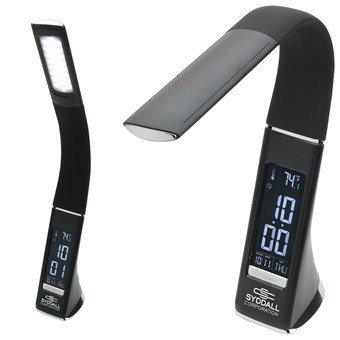
Ariel Premium Display, Inc. / PPAI 161650, S10 / www.arielpremium.com
–––––––––––––––––––––––––––––––––––––––––––––––––––––––––––
With its classic shape, this magnetic sand timer/hourglass makes for a cool desktop timer. Recipients can flip this glass timer and watch the fine metal filings work their way down to the genuine wood base with a magnetic disc, creating a uniquely striking shape each time. Each six-inch-tall timer (including the base) is individually packaged in a clear display gift box. Customize this product by adding a logo or business name to the base. 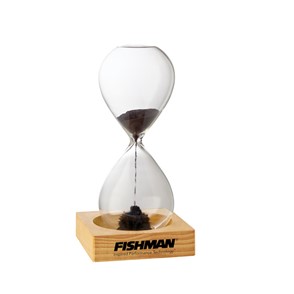
Jornik Manufacturing Corp. / PPAI 111065, S6 / www.jornik.com
–––––––––––––––––––––––––––––––––––––––––––––––––––––––––––
The iHome TIMEBASE is a sleek space-saving dual-charging Bluetooth alarm clock. Stream your music wirelessly and enjoy room-filling sound. Charge your compatible phone wirelessly and use the USB port in the back of the device to charge a secondary unit. Set alarms, take phone calls and enjoy a dimmable backlit display.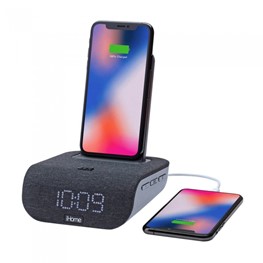
Hirsch Gift, Inc. / PPAI 221823, S10 / www.hirschgift.com
–––––––––––––––––––––––––––––––––––––––––––––––––––––––––––
Cool down and get a breath of fresh air with the LED Light Clock Desk Fan. This USB-powered office gadget is just what your clients have been waiting for. Perfect for office-bound or remote employees looking to add some pizazz to their workspace, office-centric promos, company branding, creative marketing, or for the on-the-go salesperson working from trade shows and hotel rooms. To activate the clock fan, plug into the nearest available USB port, press the button on its side and bend the clock’s silver flexy arm to direct the air flow. 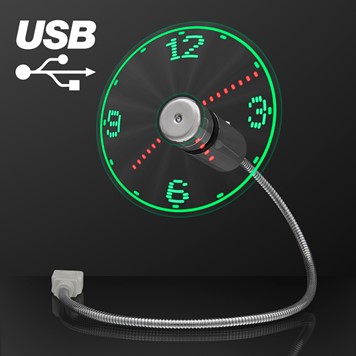
AlightPromos.com / PPAI 260234, S2 / www.alightpromos.com
–––––––––––––––––––––––––––––––––––––––––––––––––––––––––––
This iHome Color Changing Bluetooth Alarm Clock has multiple functions including fast wireless charging, a speaker system and USB charging. Wirelessly charge your compatible phone and charge a secondary device through the USB port. Recipients can set an ambiance and enjoy seven color-changing modes and awake to eight different wake-to modes. Stream music wirelessly and enjoy great audio sound or take calls hands-free through speakerphone. Connect this alarm clock to your Bluetooth-enabled phone and access Siri or Google Assistant. Set alarms and enjoy dimmable backlit buttons.
Hirsch Gift, Inc. / PPAI 221823, S10 / www.hirschgift.com
–––––––––––––––––––––––––––––––––––––––––––––––––––––––––––
Keep loved ones front and center with the Antimo Clock and Photo Frame. This foldable, brushed aluminum photo frame is four-by-six inches with a protective glass insert. Perfect for work anniversaries, this photo frame and clock will look great sitting on any desk. 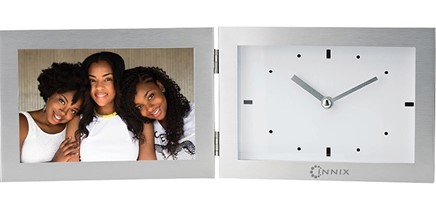
Logomark, Inc. / PPAI 110898, S12 / www.logomark.com
–––––––––––––––––––––––––––––––––––––––––––––––––––––––––––
The 3Plus Lite tracks steps taken, calories burned, distance traveled, duration of sleep and sleep cycles. It even offers users daily life reminders such as when to wake up or when to take medicine as well as a variety of smartphone applications. The device is also dust- and waterproof so recipients can wear and take it everywhere without worry. 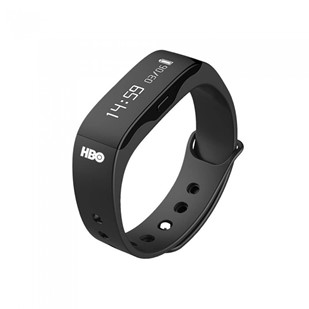
Hirsch Gift, Inc. / PPAI 221823, S10 / www.hirschgift.com
–––––––––––––––––––––––––––––––––––––––––––––––––––––––––––
Complete your workspace with the Georgetown Desk Caddy. The multi-purpose product features a metallic mesh placeholder for pencils and pens, a highly visible and easy-to-read digital calendar, alarm clock and thermometer. With two flip-open storage compartments, this a great addition for any workplace or home office. 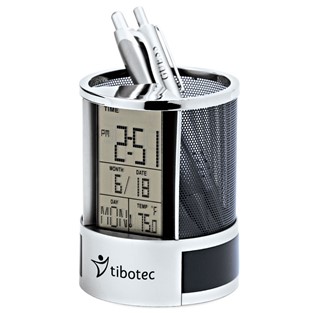
ACE Products / PPAI 216490, S6 / www.aceproductsusa.com
–––––––––––––––––––––––––––––––––––––––––––––––––––––––––––
Save space with this three-in-one calculator, picture frame and LCD digital clock. The front side features a three-and-a-half-by-five-inch photo frame display with a protective glass insert and LCD digital clock. For calculations, the back side features a metallic silver full-size desk calculator with raised black plastic buttons and 12-digit LCD digital display. Requires two AAA-batteries (included).
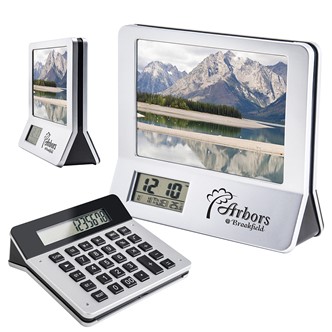
Sweda Company, LLC / PPAI 113914, S11 / www.swedausa.com
–––––––––––––––––––––––––––––––––––––––––––––––––––––––––––
Get the workday started with the BlueSequoia Alarm Clock. Ideal for home and office settings, this alarm clock is also a wireless speaker with the ability to charge enabled devices by simply placing the compatible device on top of the power bank. Recipients can pair their device from up to 30 feet away to enjoy dynamic stereo sound with a built-in microphone for easy hands-free calling. There’s also a melody alarm with adjustable volume, a snooze function and a built-in temperature gauge in Celsius/Fahrenheit. Power adapter included. 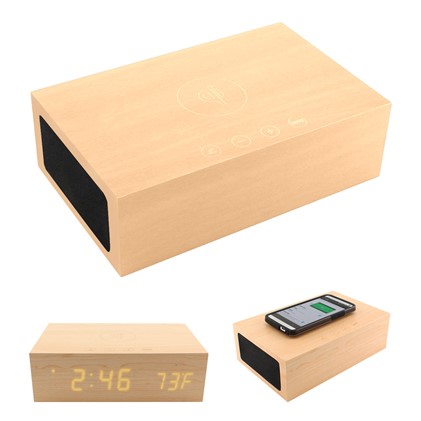
Hit Promotional Products / PPAI 113910, S13 / www.hitpromo.net
–––––––––––––––––––––––––––––––––––––––––––––––––––––––––––
Stick a pen in it with the Magnifique Series Digital Clock and Pen Stand. Available in bronze, this pen stand makes an excellent onboarding gift for new employee workspaces. Keep track of your pen and the time with this duo product. Screen printing available. 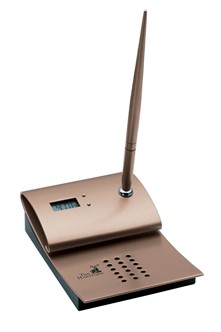
Logomark, Inc. / PPAI 110898, S12 / www.logomark.com
–––––––––––––––––––––––––––––––––––––––––––––––––––––––––––
Do more than tell time with the Healthy Bluetooth Pedometer Smart Watch. It has optical heart rate and sleep quality monitoring and a built-in GPS to track daily step count, distance traveled and calories burned. With four sport modes, outdoor running, treadmill, cycling and walking, this watch offers detailed insights into the most frequent activities. Get notifications for emails, SMS messages and incoming phone calls as well as alerts for social media and weather forecasts. This smart watch comes in four colors with a bright, always-on 1.28-inch display. Available for Android and iOS.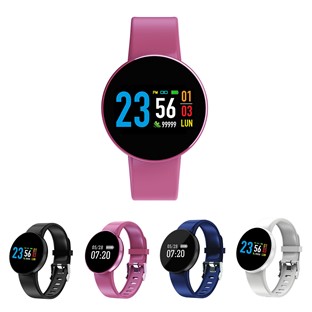
Nolwenn, LLC / PPAI 747582, S3 / www.nolwn.com
–––––––––––––––––––––––––––––––––––––––––––––––––––––––––––
This 45mm high-end A9830TR Belair watch has a solid stainless-steel case with a rose gold crown. With dial markers and scratch-resistant sapphire crystal, this recognition watch has Swiss-made chronograph movement and a genuine leather strap. With 10 ATM water resistance, this watch is available in black, blue, brown, and burgundy and with the option of a full rose gold-plated case.
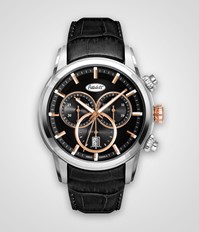
Selco / PPAI 113845, S6 / shop.selcotime.com
–––––––––––––––––––––––––––––––––––––––––––––––––––––––––––
The newly launched Futuro Gemini duet is perfect for customers with a contemporary style. Futuro Gemini timepieces feature a distinctive asymmetrical tonneau shaped stainless steel case with a blue signature Futuro edge to edge curved metalized crystal and a blue dial. The duet is also available with black dials and gold-tone stainless steel bracelets as well as black dials paired with a black silicone strap. Customization options such as case, dial and bracelet engravings vary per style.
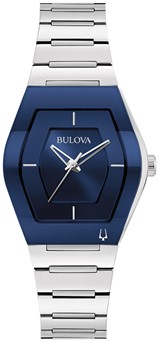
Bulova / PPAI 133171, S4 / www.cwacorporatesales.com
–––––––––––––––––––––––––––––––––––––––––––––––––––––––––––
The Corso from Citizen is a sleek, sophisticated timepiece that will always be in fashion. The duet features a stainless-steel bracelet, black dial construction and is adorned with 12 diamonds to mark the hours. The three hand watches feature has eco-drive technology, meaning it’s powered by any light. Customization options are available.
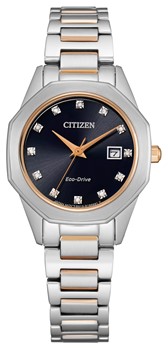
Citizen Watch America / PPAI 410292, S1 / www.cwacorporatesales.com
–––––––––––––––––––––––––––––––––––––––––––––––––––––––––––
Kristina Valdez is associate editor of PPB.

